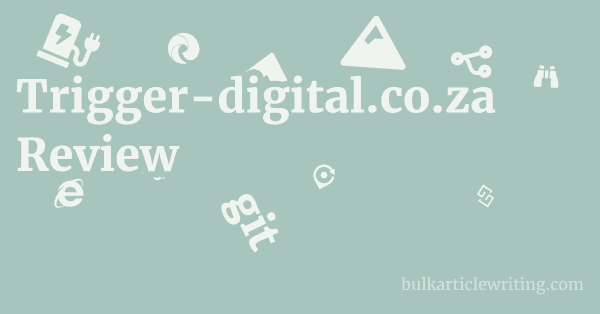One of the most frequently asked questions when engaging a digital marketing agency is about pricing. Unlike purchasing a tangible product, digital marketing services often come with varied pricing structures, making it challenging for businesses to compare agencies or budget effectively. The absence of any pricing information on trigger-digital.co.za is a significant drawback, as it leaves potential clients completely in the dark, forcing them to engage in a conversation before understanding even a ballpark figure. Reputable agencies, while not always listing exact prices, often provide clear indications of their pricing models or typical project ranges.
Common Digital Marketing Pricing Models
Agencies typically adopt one or a combination of the following pricing models:
-
Retainer-Based Pricing (Monthly/Quarterly):
- Description: This is one of the most common models, especially for ongoing services like SEO, social media management, content marketing, or paid advertising management. Clients pay a fixed monthly or quarterly fee for a set scope of work, a certain number of hours, or access to specific services.
- Pros: Provides predictable costs for the client and stable revenue for the agency. Fosters a long-term partnership approach, as the agency becomes an extension of the client’s marketing team.
- Cons: Can be less flexible if needs change rapidly. Scope creep can occur if the agreed-upon services are frequently exceeded without adjustment.
- Example: A business pays R15,000 per month for ongoing SEO optimisation, social media content creation (10 posts per month), and monthly performance reports.
-
Project-Based Pricing (Fixed Fee):
- Description: A fixed price is agreed upon for a specific, well-defined project with clear deliverables and timelines. This is typical for one-off projects like website design and development, a specific content creation campaign, a brand identity project, or a single SEO audit.
- Pros: Clear cost upfront for the client. Encourages the agency to be efficient to stay within budget.
- Cons: Requires a very precise scope definition; any significant changes or additions (“scope creep”) during the project can lead to additional charges or disputes.
- Example: A fixed fee of R50,000 for a new 10-page e-commerce website, including design, development, and basic SEO setup.
-
Hourly Rate Pricing:
0.0 out of 5 stars (based on 0 reviews)There are no reviews yet. Be the first one to write one.
Amazon.com: Check Amazon for Understanding Pricing Models
Latest Discussions & Reviews:
- Description: Clients are billed for the actual hours worked by the agency’s team members. This model is often used for consulting, ad-hoc tasks, or projects where the scope is difficult to define upfront.
- Pros: Clients only pay for the exact work done. Can be flexible for evolving projects.
- Cons: Costs can be unpredictable if the project takes longer than anticipated. Requires strong trust and detailed time tracking from the agency.
- Example: An agency charges R800 per hour for a senior consultant’s time, used for strategic planning sessions or specific troubleshooting.
-
Performance-Based Pricing: The Importance of a Genuine Portfolio in Digital Marketing
- Description: A portion or all of the agency’s fee is tied to the achievement of specific, measurable results (e.g., a percentage of increased sales, cost per lead, or ranking improvements for specific keywords).
- Pros: Aligns the agency’s incentives directly with the client’s business goals. Reduces risk for the client if the agency doesn’t perform.
- Cons: Can be complex to implement and measure accurately. Agencies may require a lower base fee to cover their operational costs. Not suitable for all types of marketing activities.
- Example: An agency charges a base monthly fee plus 10% of the revenue generated through the paid advertising campaigns they manage.
-
Commission-Based Pricing:
- Description: Common in affiliate marketing or for agencies managing large media buys, where the agency earns a percentage of the advertising spend they manage.
- Pros: Straightforward calculation for media spend.
- Cons: Can incentivise higher ad spend rather than efficiency or ROI if not structured carefully.
Why Trigger-digital.co.za’s Silence on Pricing is a Problem
The complete absence of any pricing information or even an indication of their preferred model on trigger-digital.co.za is a significant transparency issue. This forces potential clients to:
- Spend Time Without Knowing if They Can Afford It: Businesses often have budgets. Without any pricing context, a potential client has to invest time in contacting the agency, explaining their needs, and waiting for a quote, only to discover it’s far outside their budget. This is inefficient and frustrating.
- Question Transparency: Reputable agencies understand that pricing is a key factor in decision-making. While not all agencies publish exact figures, providing a range or explaining their pricing philosophy (e.g., “projects start from R10,000”) demonstrates openness.
- Infer Potential Lack of Structure: A lack of clear pricing models might suggest that the agency itself lacks a clear, structured approach to its service delivery and costing, which can lead to inconsistencies in quotes or unexpected charges later on.
In conclusion, understanding the various pricing models is crucial for businesses seeking digital marketing services. For an agency, providing at least an overview of their pricing approach or typical project costs is a hallmark of transparency and professionalism. The absence of this on trigger-digital.co.za is another indicator that it falls short of the standards expected from a reputable and client-focused digital marketing partner.

Leave a Reply